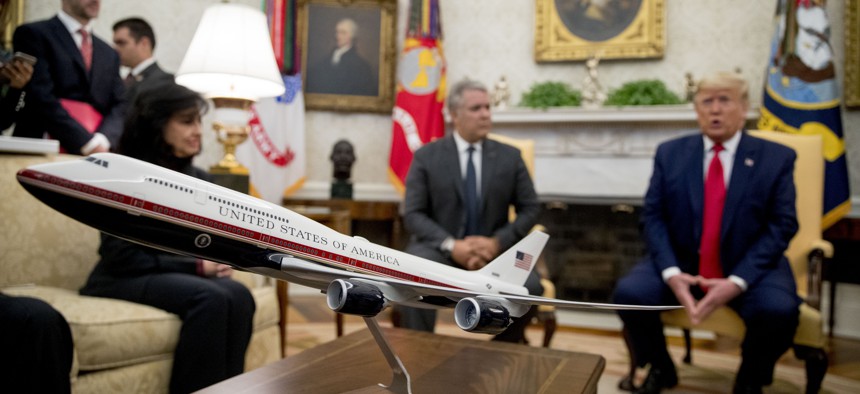
A model of the new Air Force One design sits on a table as President Donald Trump meets with Colombian President Ivan Duque in the Oval Office of the White House. AP Photo/Andrew Harnik
The Owner’s Manual for Trump’s New Air Force One Cost $84 Million
The Air Force quietly announced that Boeing’s manuals for Trump’s new $5.3 billion presidential jets are a bit pricier than your average automobile-repair guides.
Updated: 11:47 a.m.
President Donald Trump’s much-touted $4 billion deal with Boeing for two new Air Force One aircraft didn’t include a key item: the instruction manuals.
The cost of these flight and maintenance manuals: $84 million, according to a U.S. Air Force contract announcement posted Wednesday evening.
“This contract modification is to modify commercial manuals, update with VC-25B-specific information and deliver integrated manuals for the VC-25B system,” the announcement says, referring to the next Air Force One aircraft by its military designation. “This includes manuals developed by both Boeing and their subcontractors.”
The technical manuals will include more than 100,000 pages with the specifications for flying the plane as well as fixing it, according to people familiar with the high-profile project. The new manuals aren’t expected to be finished until January 2025, according to the Air Force’s announcement.
Trump has made buying a new Air Force One a priority since before moving into the White House. Shortly after being elected president, he criticized the then-$4.4 billion price tag as “out of control.” He personally negotiated with former Boeing CEO Dennis Muilenburg, and in early 2018 bragged about cutting a $3.9 billion deal.
It’s since become known that $3.9 billion does not include everything for the project. The figure includes the cost of the 747s themselves and the extensive modification work, said Air Force spokeswoman Ann Stefanek. (The Air Force has refused to disclose just how much it paid Boeing for the planes, saying that the company demanded its silence as part of the deal.)
The Air Force will spend another $1.4 billion on testing, spare parts, support equipment, training, and building new hangers at Joint Base Andrews outside Washington, D.C.
These extras bring the expected total cost of the project to $5.3 billion. The $84 million manuals are already factored into that price tag, Stefanek said.
While the cost is high, people familiar with the program said it’s in line with the cost of technical manuals for other types of weapons and equipment. For example, the Navy in August 2018 paid Boeing nearly $31 million to update a section of the P-8 Poseidon structural repair manual.
The weapon manuals are similar in spirit to automobile repair shop manuals, but far more complex. For new weapons, these blueprints and repair instructions are largely computerized. And unlike a consumer product, where the cost of technical manuals are recouped by selling millions of items, the military often buys custom-made items in small numbers. An automaker can spread the cost of its repair manual computer program and diagnostic tools over the sale of tens of millions of cars each year. The Pentagon is buying two Air Force Ones.
“I expect there is a lot of specific mission equipment that is integrated into the [new Air Force One]…that could affect the handling of the aircraft,” said Richard Aboulafia, vice president for analysis at the Teal Group, a Virginia consulting firm.
Boeing deferred all comments about the manuals to the Air Force.
The cost of any work on Air Force One is usually pricey since it’s largely customized and the people who work on the project must hold high-level security clearances. Plans to install new $24 million refrigerators on the current Air Force One were scrapped after lawmakers questioned their need.
Although the new Air Force One is a 747-8 airliner — a plane that has been flying passengers for nearly a decade — it will be incredibly bespoke inside with offices, conference rooms, and a communications center. The amount of wiring inside the aircraft will be at least double that of airliners.
Last month, the Air Force said Boeing started transforming the two planes at a company factory in San Antonio, Texas, where they will be largely dismantled and rebuilt.
“The VC-25B modifications to the 747-8 aircraft will include electrical power upgrades, a mission communication system, a medical facility, executive interior, and autonomous ground operations capabilities,” the Air Force said in a statement.
The new planes are not expected to fly a president until at least 2024.




